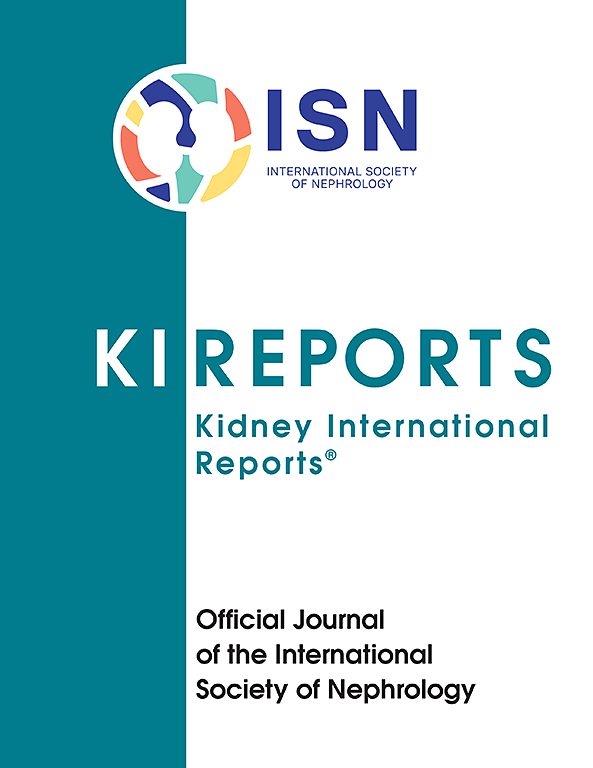Improving Blood Pressure in High-Risk Patients With CKD Using an Interdisciplinary Remote Hypertension Program
IF 5.7
2区 医学
Q1 UROLOGY & NEPHROLOGY
引用次数: 0
Abstract
Introduction
Interventions are needed to reduce racial and ethnic disparities in achieving blood pressure (BP) control among patients with chronic kidney disease (CKD). We determined the feasibility and effectiveness of an interdisciplinary remote patient monitoring (RPM) hypertension program in predominantly Black and Hispanic patients with CKD.
Methods
We evaluated an RPM hypertension program for patients with CKD in a New York City health system between July 2021 and October 2022. BP data were transmitted in real-time using a cellular-enabled BP device. Education on lifestyle and adherence was provided, and medications were adjusted by a nurse practitioner (NP) via telemedicine. Feasibility was quantitatively assessed as enrollment, participation, and retention at 3 months. Effect on BP was estimated as mean change in BP at 3 months and proportion with BP < 130/80 mmHg at 6 months.
Results
Among 111 patients invited, 102 (91.9%) enrolled and 87 (78.4%) were retained in the program for 3 months. Median age was 61 years, 50% were female, 55.9% were Black, 35.3% were Hispanic, and median estimated glomerular filtration rate was 47.5 ml/min per 1.73 m2. The median days per month that BP was measured ranged from 16 to 23. Mean change in systolic and diastolic BP from enrollment to 3 months was −15.0 ± 20.8 (P < 0.0001) and −6.7 ± 17.7 (P = 0.0007), respectively. By 6 months, 49.4% achieved BP < 130/80 mm Hg.
Conclusion
This RPM hypertension program in patients with CKD was feasible and effective in improving BP, which is promising for increasing equity in hypertension control. Future studies evaluating long-term maintenance of BP control using this approach compared with usual care are needed.

使用跨学科远程高血压项目改善高危CKD患者的血压
需要采取干预措施来减少慢性肾脏疾病(CKD)患者在实现血压(BP)控制方面的种族和民族差异。我们确定了以黑人和西班牙裔为主的CKD患者的跨学科远程患者监测(RPM)高血压项目的可行性和有效性。方法:我们评估了2021年7月至2022年10月期间纽约市卫生系统中CKD患者的RPM高血压计划。BP数据通过蜂窝式BP设备实时传输。提供生活方式和依从性教育,并由执业护士(NP)通过远程医疗调整药物。可行性在3个月时定量评估入组、参与和保留情况。对血压的影响以3个月时的平均血压变化和与BP <的比例来估计;6个月时130/80 mmHg。结果入选的111例患者中,102例(91.9%)入组,87例(78.4%)留组3个月。中位年龄为61岁,50%为女性,55.9%为黑人,35.3%为西班牙裔,估计肾小球滤过率中位数为47.5 ml/min / 1.73 m2。每月测量血压的中位数天数从16天到23天不等。收缩压和舒张压从入组到3个月的平均变化为- 15.0±20.8 (P <;0.0001)和- 6.7±17.7 (P = 0.0007)。6个月后,49.4%的患者达到了BP <;结论CKD患者采用RPM降压方案改善血压是可行和有效的,有望提高高血压控制的公平性。未来的研究需要评估使用这种方法与常规护理相比较的血压控制的长期维持。
本文章由计算机程序翻译,如有差异,请以英文原文为准。
求助全文
约1分钟内获得全文
求助全文
来源期刊

Kidney International Reports
Medicine-Nephrology
CiteScore
7.70
自引率
3.30%
发文量
1578
审稿时长
8 weeks
期刊介绍:
Kidney International Reports, an official journal of the International Society of Nephrology, is a peer-reviewed, open access journal devoted to the publication of leading research and developments related to kidney disease. With the primary aim of contributing to improved care of patients with kidney disease, the journal will publish original clinical and select translational articles and educational content related to the pathogenesis, evaluation and management of acute and chronic kidney disease, end stage renal disease (including transplantation), acid-base, fluid and electrolyte disturbances and hypertension. Of particular interest are submissions related to clinical trials, epidemiology, systematic reviews (including meta-analyses) and outcomes research. The journal will also provide a platform for wider dissemination of national and regional guidelines as well as consensus meeting reports.
 求助内容:
求助内容: 应助结果提醒方式:
应助结果提醒方式:


